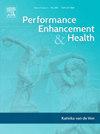Mirror reflections and energy deficits: Exploring the role of body image as a predictor of relative energy deficiency in sport (REDs)
IF 3.7
Q2 HOSPITALITY, LEISURE, SPORT & TOURISM
引用次数: 0
Abstract
Body image is a powerful psychological construct, shaping how athletes perceive, engage, and endure within their sport. Yet, its critical role in the etiology and perpetuation of Relative Energy Deficiency in Sport (REDs) remains underestimated. Although diagnostic frameworks such as the REDs Clinical Assessment Tool (REDs CAT) identify key behavioural and physiological indicators, body image disturbances, despite their associations with disordered eating, compulsive exercise, and psychological distress, are not explicitly emphasized.
This review examines the intricate nexus between body image and REDs, elucidating its role as a catalyst for maladaptive behaviours and a harbinger of physiological and psychological decline. Athletes, particularly those in lean-body and aesthetic sports, face disproportionate vulnerability, as the cultural valorisation of performance and appearance converges with internalised body dissatisfaction to exacerbate energy deficits and psychological distress. Despite mounting evidence, body image remains a peripheral concern in REDs screening and intervention.
We advocate for an expanded research agenda that positions body image not as a diagnostic criterion, but as a potentially important upstream factor in REDs risk. Longitudinal, theory-driven studies are needed to clarify its role in both the development and resolution of REDs, and to inform more holistic screening and intervention strategies. Recognizing body image as both a possible contributor to and consequence of REDs may support more tailored, psychologically informed approaches to athlete care.
This call-to-action invites researchers, clinicians, and sport organizations to reimagine REDs through a lens that prioritises psychological resilience alongside physical performance, ensuring a more sustainable future for athletes.
镜子反射和能量不足:探索身体形象作为运动中相对能量不足的预测因子的作用(red)
身体形象是一种强大的心理结构,塑造了运动员在运动中如何感知、参与和忍受。然而,它在运动中相对能量缺乏(red)的病因和持续存在中的关键作用仍被低估。尽管red临床评估工具(red CAT)等诊断框架确定了关键的行为和生理指标,但身体形象障碍(尽管与饮食失调、强迫性运动和心理困扰有关)并未得到明确强调。这篇综述探讨了身体形象和red之间复杂的联系,阐明了它作为适应不良行为的催化剂和生理和心理衰退的先兆的作用。运动员,尤其是那些瘦体运动和审美运动的运动员,面临着不成比例的脆弱性,因为对表现和外表的文化价值评价与内在的身体不满融合在一起,加剧了能量不足和心理困扰。尽管有越来越多的证据表明,身体形象在红血球筛查和干预中仍然是一个次要问题。我们提倡扩大研究议程,将身体形象定位为red风险的潜在重要上游因素,而不是诊断标准。需要进行纵向的、理论驱动的研究,以阐明其在红血病的发展和解决中的作用,并为更全面的筛查和干预策略提供信息。认识到身体形象既是red的可能诱因,也是red的后果,可能会支持更有针对性的、心理知情的运动员护理方法。这一行动呼吁邀请研究人员、临床医生和体育组织通过优先考虑心理弹性和身体表现的镜头重新构想red,确保运动员拥有更可持续的未来。
本文章由计算机程序翻译,如有差异,请以英文原文为准。
求助全文
约1分钟内获得全文
求助全文
来源期刊

Performance enhancement and health
Social Sciences-Health (social science)
CiteScore
4.70
自引率
0.00%
发文量
27
审稿时长
57 days
 求助内容:
求助内容: 应助结果提醒方式:
应助结果提醒方式:


